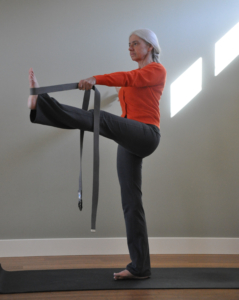Last month I wrote about Garudhasana (Eagle Pose), a pose that honors Garuda, the eagle god whose 40-mile wingspan caused hurricanes and dried up the oceans whenever he took flight. Garudhasana spreads our wings (shoulderblades) and our deep hip rotators, preparing us for flight. In a sense it is a jumping-off point for the expansion that April—derived from the Latin word aperire, meaning “to open”— symbolizes. This month’s pose, Utthita Hasta Pangusthasana (Extended Hand to Big Toe Pose) expresses the unfurling of our bodies to take flight.
Utthita Hasta Padanghustasana (utthita=extended, hasta=hand, padangusthasana=big toe pose) does not have Garudhasana’s colorful mythology. The name simply describes the shape of the pose. It is one of a category of poses my students have named “flying poses.” Flying poses are poses that express expansion. In flying poses, the root of the pose (whatever’s on the ground) extends deep into the ground, while the rest of the body expands outward and upward, away from the earth. The opening comes from stability and the flying part comes from a developmental breathing pattern called navel radiation.
Before we are born, all the nutrients we consume are taken in through our navels via the umbilical cord, and distributed to the periphery of our bodies in a pattern that resembles a starfish. In our first six months, our natural breathing pattern looks like a starfish, with the breath movement originating in the abdomen and radiating out into our limbs. Remembering and practicing this breathing pattern can revitalize our asana practice. While all yoga asanas can express this pattern, Utthita Hasta Padangusthasana does it especially well.
Flying Lesson
To practice Utthita Hasta Padangusthasana, begin standing on a thin yoga mat or directly on the floor. Place your feet hips-width apart. Close your eyes and become aware of your feet. Feel how the feet constantly make micro-adjustments in order to keep you upright. This is the nature of balance—constant and dynamic. Balance is not about reaching some “perfect” position and holding onto it; it’s about trusting your body’s own proprioceptive awareness to make the adjustments needed to keep you dynamically upright. Balance, then, is about being mindful—and open—to the constant changes inherent in our bodies and in our lives, and responding to these changes with ease.
Now shift your body to the right, letting the weight settle into your right foot. Bend your left knee lifting your foot off the floor. Find equilibrium here. When you feel balanced, bend your left knee further until you can hold your left foot with your left hand. You may either take the outside of the foot or curl your index and middle fingers around the inside of your big toe. Place your right hand on your hip and find stability, feeling how your right foot is constantly shifting to keep your body in balance. (If balance eludes you, you may do this pose standing with your back to a wall and let your buttocks rest against the wall.)
Simultaneously begin to unfurl the left leg forward and the right arm out from the shoulder so that they open gradually like a blossoming flower, until both reach full extension. Extend the arm and leg with equal intention, so that they balance each other. Continue to feed your body’s weight into your standing leg.
If your hamstrings are tight and you can’t straighten your leg without hunching your body forward, place a strap or belt around your left foot and hold the belt with your left hand. As you unfurl your right arm and left leg, let your hand slide on the strap so that you can fully straighten your leg.
In balance poses, our minds tend to be more interested in the parts of the body that are moving and changing. The stable, standing leg, while not as exciting to the mind, is more important, so as you extend your limbs, keep awareness in the standing leg.
When you feel stable, explore expansion through all the limbs, including both arms and legs, and the head and tailbone. Let the breath originate at your navel and expand outward so that your asana pulses—expanding on the inhalation and settling on the exhalation. Take five to ten slow, deep breaths. Then release your hold on the left leg, letting your left foot return to the floor. Return to standing equally on both feet and let your arms rest at your sides. Close your eyes and feel what happened in the pose. How has your body/mind changed? Then repeat the pose on the other side.
Expansion comes from stability. Every blossoming tree and flower expands from its roots. So do our bodies. Utthita Hasta Padangusthasana teaches us about the dynamic relationship between openness and stability. We expand on the inhalation and settle on the exhalation. Garudhasana helped you spread your wings to prepare for flight. Padangusthasana takes you airborne.

